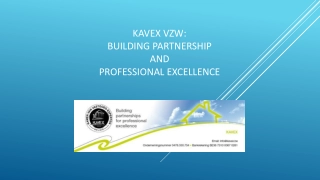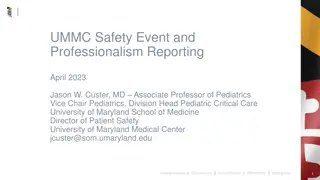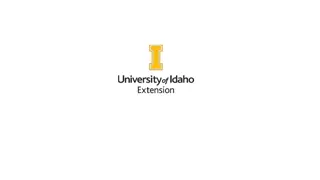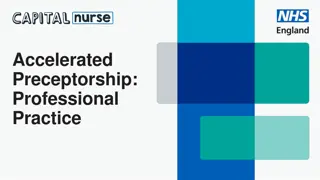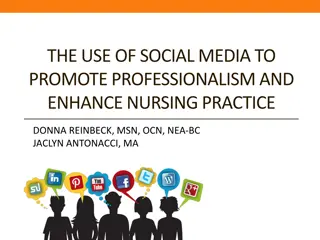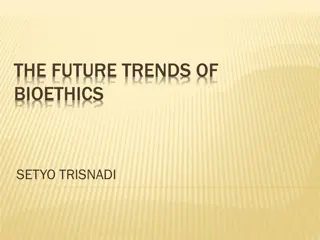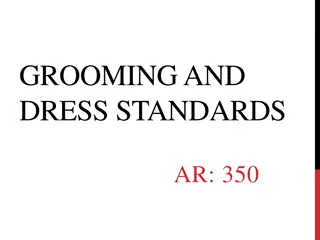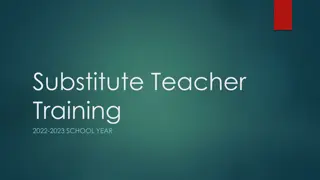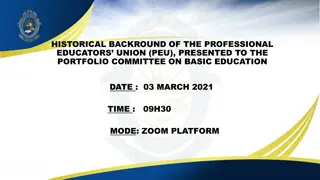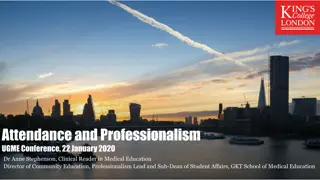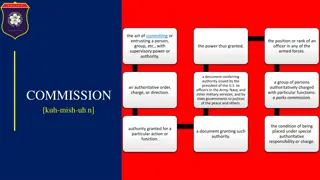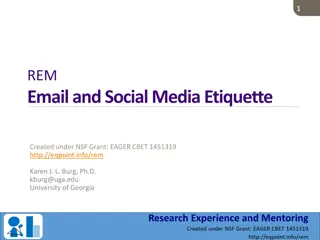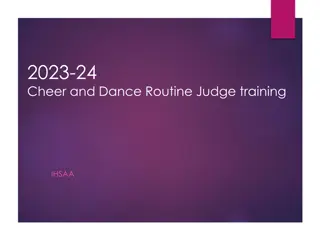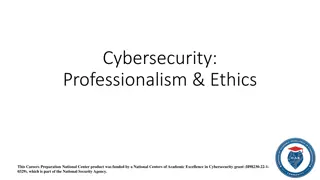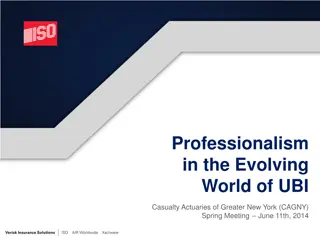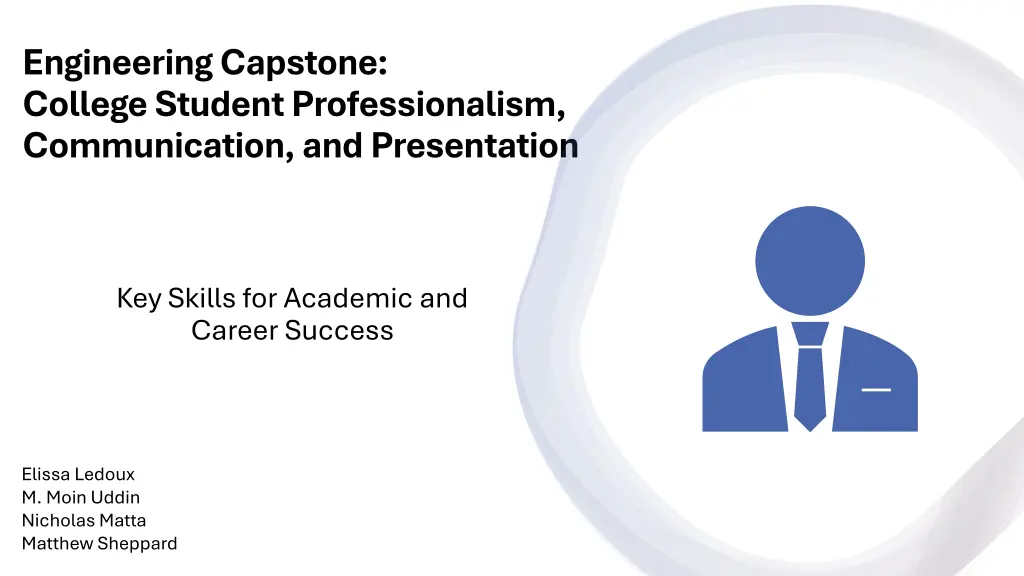
Enhancing College Success with Professionalism, Communication, and Presentation Skills
Explore the significance of professionalism, effective communication, and key presentation techniques for academic and career triumph. Learn about building trust, academic integrity, and communication essentials for success in college and beyond.
Download Presentation

Please find below an Image/Link to download the presentation.
The content on the website is provided AS IS for your information and personal use only. It may not be sold, licensed, or shared on other websites without obtaining consent from the author. If you encounter any issues during the download, it is possible that the publisher has removed the file from their server.
You are allowed to download the files provided on this website for personal or commercial use, subject to the condition that they are used lawfully. All files are the property of their respective owners.
The content on the website is provided AS IS for your information and personal use only. It may not be sold, licensed, or shared on other websites without obtaining consent from the author.
E N D
Presentation Transcript
Engineering Capstone: College Student Professionalism, Communication, and Presentation Key Skills for Academic and Career Success Elissa Ledoux M. Moin Uddin Nicholas Matta Matthew Sheppard
Introduction Overview: Professionalism, communication, and presentation skills are essential for success in both academic and professional environments. These skills help in building a positive reputation, effective collaboration, and successful career advancement. Objectives: Define professionalism and its importance. Discuss effective communication skills. Explore key presentation techniques.
What is Professionalism? Definition: Professionalism refers to the conduct, aims, or qualities that characterize a professional person. Key Characteristics: Accountability:Taking responsibility for your actions. Reliability:Being dependable and consistent. Ethical Behavior:Adhering to moral principles and standards. Competence:Demonstrating the necessary skills and knowledge. Defining Professionalism Importance: Builds Trust and Respect: Professional behavior fosters trust and respect from peers and faculty. Enhances Reputation:A professional demeanor enhances your personal and academic reputation. Prepares for Professional World:Professionalism in college prepares you for future career environments.
Professional Behavior in College Examples of Professional Behavior: Punctuality: Arriving on time for classes and meetings shows respect for others time. Respect: Treating peers, faculty, and staff with courtesy and consideration. Academic Integrity: Avoiding plagiarism and cheating, and adhering to academic honesty policies. Benefits: Improved Academic Performance: Professional behavior often leads to better grades and academic success. Positive Relationships: Building positive relationships with faculty and peers can lead to mentorship and networking opportunities. Preparation for Professional Environments: Developing professional habits in college prepares you for the expectations of the workplace.
Effective Communication Skills Types of Communication: Key Elements: Verbal: Speaking clearly and confidently in class discussions and presentations. Non-verbal:Using appropriate body language, eye contact, and facial expressions to convey your message. Written:Writing clear and concise emails, reports, and essays. Clarity: Ensuring your message is easily understood by avoiding jargon and being specific. Conciseness: Being brief and to the point, avoiding unnecessary details. Coherence:Ensuring a logical flow of ideas, making it easy for the audience to follow.
Communication in Academic Settings Email Etiquette: Classroom Communication: Professional Structure: Use a clear subject line, proper greetings, and a concise message. Example, Subject: Request for Meeting to Discuss Project. Common Pitfalls: Avoid slang, overly casual language, and typos. Example, instead of Hey, can u help me with my paper? use Dear Professor [Last Name], could you please assist me with my assignment? Participating in Discussions:Engaging actively and respectfully in class discussions, sharing your thoughts and listening to others. Asking Questions:Seeking clarification and deeper understanding by asking relevant questions during lectures.
Presentation Skills Components of a Good Presentation: Structure: Clear introduction, body, and conclusion. Start with an engaging introduction, presenting key points in the body, and summarizing in the conclusion. Visual Aids: Using slides, charts, and videos to enhance understanding. Delivery: Effective voice modulation, eye contact, and body language. Maintain eye contact with the audience and use hand gestures to emphasize points. Tips: Keep Slides Simple: Avoid clutter and use bullet points for key information. Use Visuals: Include images, charts, and videos to support your points. Practice Delivery: Rehearse your presentation multiple times to build confidence.
Preparing for a Presentation Steps to Prepare: Research: Gather relevant information and data from credible sources. Content Creation: Develop a clear and logical flow of ideas, ensuring each slide has a specific purpose. Slide Design Tips: Use consistent fonts and colors, avoid too much text, and include visuals. For example, using a consistent color scheme and font style throughout the presentation. Rehearsal Techniques: Practice in front of a mirror or with friends, time your presentation, and refine your delivery. For example, recording yourself to identify areas for improvement.
Overcoming Presentation Anxiety Tips and Techniques: Practice and Preparation: The more you practice, the more confident you will feel. Rehearse your presentation multiple times. Breathing Exercises: Deep breathing can help calm nerves. Take deep breaths before starting your presentation. Positive Visualization: Imagine yourself giving a successful presentation. Visualizing the audience reacting positively to your presentation. Focus on the Message: Concentrate on the content rather than the audience. Focus on delivering your key points effectively.
Conclusion and Action Steps Action Steps: Apply Professionalism: Start practicing professional behavior in your daily academic life. Enhance Communication:Work on improving your verbal, non- verbal, and written communication skills. Practice Presentations:Take every opportunity to practice and refine your presentation skills.

